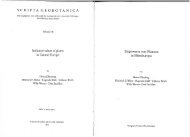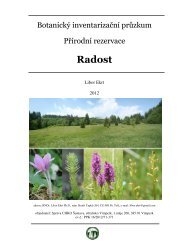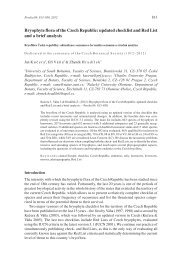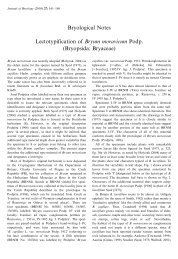Italian balustrade at Cliveden hosts Italian lichens?
Italian balustrade at Cliveden hosts Italian lichens?
Italian balustrade at Cliveden hosts Italian lichens?
Create successful ePaper yourself
Turn your PDF publications into a flip-book with our unique Google optimized e-Paper software.
Verrucaria nigrescens with other species such as Bagliettoa calciseda, Caloplaca variabilis,<br />
Solenopsora candicans, Toninia arom<strong>at</strong>ica and Verrucaria fuscella in smaller quantities.<br />
Caloplaca calcitrapa growing on the terrace <strong>balustrade</strong>, <strong>Cliveden</strong><br />
An unfamiliar specimen of Caloplaca with yellow bull<strong>at</strong>e areoles was collected<br />
(February 2012) from the newer <strong>balustrade</strong> and this was found to have thick-walled,<br />
“sand-clock” type spores. Arup (2006) st<strong>at</strong>es th<strong>at</strong> this type of spore is unique to<br />
Caloplaca dichroa in northern Europe, but these spores also occur in C. calcitrapa, a<br />
species restricted to the Mediterranean Basin (Navarro-Rosinés et al. 2000). The<br />
specimen from <strong>Cliveden</strong> fits well the description of C. calcitrapa but we were sceptical<br />
and wanted to confirm placement of the English lichen by molecular fingerprinting.<br />
Our first <strong>at</strong>tempt <strong>at</strong> genetic sequencing failed, perhaps due to the small amount of<br />
scraped m<strong>at</strong>erial or by strong contamin<strong>at</strong>ion with the glue Copydex. We suspected<br />
th<strong>at</strong> there may be further species of Caloplaca in Europe which have thick-walled<br />
spores and so we wavered with the identific<strong>at</strong>ion. A second, more richly fertile<br />
specimen was recently collected and this was confirmed as C. calcitrapa by reference<br />
to the ITS sequence (see below); unfortun<strong>at</strong>ely the specimen has been almost<br />
destroyed by removing parts for sequencing.<br />
We are left to specul<strong>at</strong>e whether C. calcitrapa, like the little snail, was imported<br />
to <strong>Cliveden</strong> from the Borghese Gardens in Rome or whether it is an overlooked<br />
member of our n<strong>at</strong>ive mycota. If it was imported, it appears to have disappeared<br />
12










